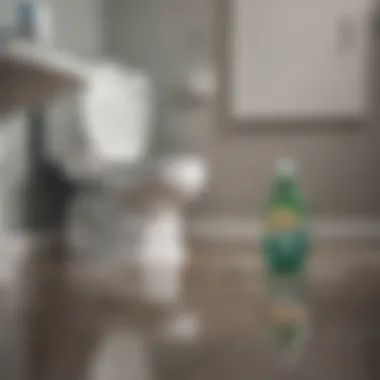Evaluating Dish Soap for Toilet Clogs: Is It Effective?


Intro
Toilet clogs are a common household issue, often leading to frustration and inconvenience. The relentless build-up of waste, toilet paper, or foreign objects can result in a blockage that disrupts daily life. Traditional solutions for clogs often involve plungers, snake tools, or chemical drain cleaners. However, in recent years, homeowners have begun to explore alternative methods, including the use of dish soap. This article examines the effectiveness of dish soap as a potential remedy for toilet clogs, illuminating its properties, discussing clog formation, and considering other methods for dealing with blockages.
Understanding Toilet Clogs
Understanding toilet clogs is essential for proper plumbing maintenance and homeowner awareness. Toilets are a critical component in every household, and their proper function is often taken for granted until an issue arises. It is important to comprehend what causes clogs and how they affect plumbing systems. This knowledge can empower homeowners to take timely action that prevents minor issues from escalating into costly repairs.
Common toilet clogs can lead to significant household disruptions. Knowledge of the specific causes not only helps in immediate troubleshooting but also aids in taking preventive measures. Recognizing the signs of a clog early can save time, money, and stress.
Additionally, understanding how clogs impact plumbing can inform better choices regarding cleaning products and methods. With various solutions available, including household items like dish soap, having a strong foundational knowledge about the subject will allow for a more informed decision on the best course of action when faced with a clog.
Common Causes of Toilet Clogs
Toilet clogs can stem from several sources. It is crucial to identify these common causes to prevent and address blockages effectively. Here are some of the main culprits:
- Excessive Toilet Paper: One of the leading causes of clogs is the use of an excessive amount of toilet paper, which does not dissolve effectively in water.
- Foreign Objects: Items such as toys, personal hygiene products, or anything that should not go down the toilet can create blockages.
- Flushable Wipes: While often marketed as flushable, many wipes do not break down in water, leading to buildup in plumbing systems.
- Hard Water Deposits: Minerals can accumulate over time, narrowing pipes and making it easier for waste to get stuck.
Being aware of these issues enables proactive measures like educating household members about what can or cannot be flushed.
The Impact of Clogs on Plumbing
Toilet clogs have a significant impact on plumbing systems. When water cannot flow freely, it creates pressure within the pipes. This pressure can lead to:
- Damage to Pipes: Constant pressure can cause pipes to crack or burst, leading to expensive repairs.
- Backflow Issues: Clogs can lead to backflow, which may create health hazards due to contamination.
- Inefficiency: Clogged toilets can result in inefficient flushing, forcing users to flush multiple times and wasting water.
Understanding the effects of clogs emphasizes the importance of timely intervention in maintaining plumbing integrity. A good approach combines knowledge of causes and their effects, which ultimately cultivates better plumbing habits.
Prelude to Dish Soap
Dish soap serves as an essential product in any household, going far beyond its primary function of cleaning dishes. Its role in tackling common plumbing issues, particularly toilet clogs, deserves attention. Understanding what dish soap is and how it interacts with plumbing can demystify its potential as a remedy for clogs. This section aims to provide insights into the composition and various applications of dish soap, laying a foundation for evaluating its effectiveness in unclogging toilets.
Composition and Properties
Dish soap is typically composed of surfactants, which are substances that lower the surface tension of liquids. These surfactants enable the soap to spread and penetrate surfaces effectively. The primary surfactants found in dish soaps, such as sodium lauryl sulfate and sodium laureth sulfate, contribute to their cleaning power by breaking down grease and grime.
Apart from surfactants, dish soap often contains stabilizers and preservatives that ensure its longevity and efficacy. These ingredients are generally safe for household use, making dish soap a popular choice. Its ability to create lather also aids in covering more surfaces, which can become advantageous when dealing with stubborn clogs.
The lubricating properties of dish soap are particularly important in this context. When used in drains, the soap can help to coat the materials within the plumbing, allowing blockages to dissolve or slide more readily. While dish soap may not completely eliminate a severe clog, its properties may assist in alleviating the pressure within the pipes.
Common Uses of Dish Soap
Beyond washing dishes, dish soap finds its utility in several areas:
- Cleaning Surfaces: It is effective for cleaning countertops, appliances, and other surfaces in the kitchen and bathroom.
- Stain Removal: Dish soap can effectively tackle various stains on fabrics and carpets, making it a versatile cleaning agent.
- Pest Control: Some people use a diluted solution of dish soap to combat insects in gardens and homes.
- Unclogging Toilets: As discussed in this article, dish soap is sometimes deployed as a remedy for toilet clogs due to its lubricating properties.


Employing dish soap in these contexts can enhance cleaning efficiency, promote hygiene, and even address unexpected home maintenance issues.
"Understanding dish soap's composition sheds light on its potential benefits in plumbing solutions."
As we explore the use of dish soap for toilet clogs, recognizing its chemical makeup and varied applications can help clarify its effectiveness. This background not only provides a basis for the practical applications discussed later but also allows homeowners to make informed decisions about how to tackle clogs and maintain their plumbing.
Can Dish Soap Unclog a Toilet?
In the context of household maintenance, the query of whether dish soap can effectively unclog a toilet remains significant. Toilets are essential components of any home, and addressing clogs promptly keeps homes functioning smoothly. Dish soap’s popularity as a potential remedy stems from its common use in households and its slipery properties. This section explores how and why dish soap might work against toilet clogs and what considerations homeowners should keep in mind before trying this method.
Mechanics of Lubrication
The primary function of dish soap in unclogging toilets is its ability to reduce friction. Dish soap is formulated with surfactants, which are compounds that lower the surface tension of liquids. When added to a clogged toilet, the soap creates a slick environment within the pipes. This lubrication may facilitate the movement of the trapped material.
The effectiveness of lubrication plays a key role in resolving blockages. One could compare this to the way oil eases movement between two friction-prone surfaces. In essence, dish soap can help grease the path through which waste and debris must travel, potentially enabling it to break free of the clog.
"Dish soap acts as a lubricant, making it easier for the trapped material to move through the pipes."
Comparative Efficiency
When it comes to unclogging methods, dish soap presents both advantages and limitations compared to traditional techniques.
Consider this:
- Cost-Effective: Dish soap, being widely available in kitchens, does not require additional purchases.
- User-Friendly: It is straightforward to apply and does not necessitate special tools or extensive knowledge of plumbing.
- Less Harsh: Unlike chemical drain cleaners that may corrode pipes over time, dish soap is generally safe for most plumbing systems.
However, its efficacy can vary. Dish soap may not dissolve all types of blockages. For instance, stubborn clogs caused by solid debris or significant buildup may require more aggressive interventions like plungers or toilet augers. Recognizing when to step beyond dish soap is crucial for effective plumbing maintenance. A balanced approach typically leads to the best outcomes, particularly for persistent clogs.
Step-by-Step Guide to Using Dish Soap
Using dish soap to unclog a toilet can be a practical approach for homeowners seeking effective solutions. This method is praised for its simplicity and accessibility, making it a worthwhile consideration before employing more intensive methods. Here, we will break down the process into manageable steps, emphasizing the necessary preparations and techniques required for optimal results. Understanding this method is crucial as it highlights an innovative way to address common plumbing issues without resorting to harsh chemicals, thereby promoting sustainability in household maintenance.
Preparing the Area
Before starting the unclogging process, it is essential to prepare the area properly. This involves clearing the space around the toilet and ensuring that everything is ready for clean-up. Here are some key steps to follow:
- Remove rugs and towels: Take away any items that could get wet or stained.
- Put on gloves: Protect your hands from bacteria and any potentially harmful substances.
- Cover the floor: Use old towels or newspapers around the base of the toilet to absorb any spills.
- Check the water level: It’s helpful to know how much water is in the toilet bowl, as this will affect the effectiveness of the dish soap.
By taking these precautions, you reduce the risk of mess and create a safer environment for the unclogging process.
Application Method
The actual application of dish soap is straightforward. Here is a simple method to follow:
- Pour dish soap into the toilet bowl: Use about one cup of dish soap, pouring it from a height to allow it to penetrate the clog effectively.
- Let it sit: Allow the dish soap to sit for about 15-20 minutes. This step is crucial, as it gives the soap time to work into the blockage and lubricate the pipes.
- Flush with hot water: After the waiting period, heat some water to just below boiling and carefully pour it into the bowl. The hot water helps to loosen the clogged material further while the soap continues to lubricate.
- Try flushing: After a few moments, attempt to flush the toilet. This action will help determine if the clog has been cleared.
If the water drains as expected, you're likely successful. If not, you may need to repeat the process or try other methods.
Concluding the Process


Once you have completed the steps, it is essential to evaluate the outcome:
- Assess the flush: Check if the toilet flushes smoothly without the water bubbling back or rising excessively.
- Clean the area: Clean any spills or residues from the toilet and surrounding area. Proper sanitation is vital after dealing with plumbing issues.
- Monitor performance: Keep an eye on the toilet's performance over the next few days. If clogs continue to occur, it may indicate a more serious plumbing issue that requires professional intervention.
Using dish soap as a remedy for toilet clogs offers a cost-effective and environmentally friendly option, but it is not always guaranteed to work. For complicated or persistent clogs, seeking additional support may be necessary.
Alternative Methods for Unclogging Toilets
When dealing with clogged toilets, it's essential to consider various methods for unclogging. Dish soap is one potential solution, but knowing alternative methods can provide a more comprehensive approach to resolving toilet issues. In this section, we explore the merits of three alternative methods — the plunger technique, the toilet auger, and chemical drain cleaners. Each option has its benefits and drawbacks, making it important to understand their applications and any associated risks.
Plunger Technique
The plunger is probably the most recognized tool for clearing toilet clogs. It works by creating a vacuum that helps dislodge the blockage. Here are some key aspects of using a plunger:
- Selection of the Plunger: Choosing the right type of plunger is critical. A flange plunger, specifically designed for toilets, creates a better seal and improves suction.
- Technique Basics: Insert the plunger into the bowl, ensuring it covers the drain. Push down gently to eliminate air. Then, apply firm strokes like pulling back swiftly to maximize suction. Repeat until the clog clears.
- Advantages: This method is often effective for minor clogs, is environmentally friendly, and doesn’t require any chemicals.
- Considerations: If the clog persists after several attempts, deeper issues may exist that require professional attention.
Using a Toilet Auger
A toilet auger, also known as a plumbing snake, is another effective tool for tackling stubborn clogs that the plunger cannot resolve. Here are its features:
- How It Works: The auger features a long flexible cable with a coiled end that can reach deeper into the toilet drain. It is designed to break through or retrieve the obstruction.
- Application: Insert the auger into the toilet bowl and turn the handle, allowing the cable to work its way into the drain. This may require some effort depending on the severity of the blockage.
- Benefits: This method can tackle more significant clogs and is reusable for future issues.
- Cautions: Ensure to follow safety guidelines to prevent damage to the toilet’s ceramic surface. It’s also important to wear gloves due to the potential for unsanitary conditions.
Chemical Drain Cleaners
Chemical drain cleaners are potent substances designed to dissolve clogs quickly. Here are some essential points:
- Types of Cleaners: There are alkaline, acid, and enzyme-based options available, each serving different types of clogs.
- Effectiveness: They can be effective for a range of blockages. However, their strong chemical nature can also present risks.
- Usage Guidelines: When using chemical drain cleaners, always read instructions carefully, and avoid mixing different types, as this can cause dangerous reactions.
- Environmental Concerns: These products can be harmful to plumbing and the environment. They may also cause corrosive damage over time.
"Using proper tools and techniques is critical for clearing clogged toilets. Each method has its pros and cons, requiring informed decision making."
Considering these alternatives equips homeowners with broader strategies for toilet maintenance. Assessing the type of clog and selecting the appropriate method increases the chance of a successful outcome.
Risks and Considerations
When discussing the use of dish soap for unclogging toilets, it is essential to consider the potential risks and challenges that accompany this approach. Understanding these factors helps homeowners make an informed decision about their plumbing issues.
Potential for Damage
Using dish soap in a toilet might seem harmless, but it carries the risk of causing damage under specific circumstances. First, the soap may not completely dissolve in cold water. This accumulation can lead to residue buildup, which might aggravate the clog further, creating more severe blockages in the plumbing system.
Additionally, excessive amounts of dish soap can create significant amounts of foam, especially if there is a considerable amount of wastewater in the toilet. This foaming may cause overflow, risk staining the toilet and surrounding area, or result in messy clean-up operation. In some cases, chemicals in the dish soap may interact adversely with materials in the toilet or plumbing, leading to corrosion over time.
Homeowners must evaluate the specific situation carefully before resorting to this method. If the clog is severe or has persisted for a long time, it may be unwise to rely solely on dish soap as a remedy.
Environmental Impact of Dish Soap
Dish soap is formulated with various surfactants and detergents, which can have various effects on the environment when used in excess. While the occasional use of dish soap in toilets may not present a significant threat, consistently using it for unclogging can lead to chemical runoff into the sewage system. This runoff can ultimately affect local water bodies and ecosystems.


Furthermore, certain brands of dish soap may contain phosphates or other harmful chemicals that contribute to water pollution. When these substances enter waterways, they can promote algae blooms, which deplete oxygen levels and harm aquatic life.
As both a homeowner and a responsible user, it is wise to consider eco-friendly alternatives or seek professional plumbing help when addressing significant clogs. This approach not only minimizes the potential environmental impact but also ensures the long-term health of your plumbing system.
"Understanding the risks and considering the environment are paramount when using dish soap in plumbing."
Finale
The conclusion of this article serves as a critical synthesis of all the information presented regarding the use of dish soap as a solution for toilet clogs. It is important for the reader to take away not only the efficiency of dish soap but also the potential downsides that could arise from its use in plumbing systems.
Weighing the Effectiveness
Dish soap has gained attention for its ability to unclog toilets in some circumstances. Its lubricating properties can aid in breaking up and moving along debris. However, the effectiveness often depends on various factors including the nature of the clog.
- Nature of Clog: Some clogs are caused by solid objects, where dish soap may not have any significant effect.
- Application: Using the right method and amount of dish soap is essential. Overuse could lead to excess soap residue.
- Temperature: Warm water is preferable as it can enhance the soap's action to dissolve matter better.
Ultimately, while dish soap can work as a temporary fix, it may not resolve more severe or persistent clogs.
Recommended Practices for Maintenance
Prevention is often the best approach when it comes to plumbing. Here are some recommended practices to keep toilets functioning:
- Routine Checks: Regularly inspect flush mechanisms and seals.
- Mind What Goes Down: Only flush items designed to break down easily in waterways.
- Periodic Cleaning: Consider using natural cleaning agents periodically to maintain hygiene and functionality.
Homeowners and those managing plumbing issues should adopt these habits as they are more effective in ensuring robust plumbing health. Combining these practices with the occasional use of dish soap might create a balanced approach to managing clogs in the long term.
"Understanding your plumbing and how everyday items like dish soap can impact it is crucial for effective home maintenance."
By weighing both effectiveness and maintenance practices, individuals can better navigate plumbing challenges while minimizing future complications.
Further Reading and Resources
In any subject matter, particularly those involving household maintenance and plumbing, further reading and resources play a significant role. They provide invaluable insights and detailed guidance that complement the information presented in this article. For those interested in using dish soap as a remedy for toilet clogs, understanding the broader context is essential. This section will guide readers to key resources that can expand their knowledge and improve their problem-solving skills regarding clogs and plumbing issues.
Books on Household Management
Books dedicated to household management often cover a range of essential topics, including cleaning, maintenance, and effective troubleshooting strategies for everyday problems. These texts can help readers gain insight into comprehensive household care, providing practical advice that can save time and money. Some titles focus specifically on plumbing issues, while others offer a holistic view of home management.
Key benefits of reading these books include:
- In-depth Knowledge: Understanding household management strategies helps prevent problems like clogs in the first place.
- Expert Advice: Many authors are professionals in their field, offering reliable information based on experience.
- Practical Solutions: Readers often find actionable strategies that they can apply directly to their homes.
A few recommended titles might include "Home Comforts: The Art and Science of Keeping House" by Cheryl Mendelson, and "The Complete Do-It-Yourself Manual" published by Editors of Family Handyman. These resources can equip homeowners with the knowledge required to manage their plumbing effectively.
Online Guides for Plumbing Issues
Online resources provide quick access to a range of plumbing guides and forums where individuals share their experiences and solutions. Websites such as reddit.com feature communities that discuss plumbing challenges, including clogs, and how dish soap is viewed as a potential solution. Wikipedia and Britannica hold structured articles on plumbing basics and household maintenance tips that can further enhance understanding.
Essential elements of online guides include:
- Current Trends: Online platforms often offer up-to-date solutions and discussions reflecting recent findings in plumbing technology.
- Diverse Perspectives: Engaging with online communities can provide varying viewpoints and strategies based on personal experiences.
- Accessibility: Most online resources are free, making them available to anyone looking to enhance their understanding of plumbing issues.
As readers engage with these online guides, they can find step-by-step instructions, video tutorials, and helpful tip sheets. These platforms can demystify plumbing problems and enable readers to tackle clogs or other issues with confidence and knowledge.







